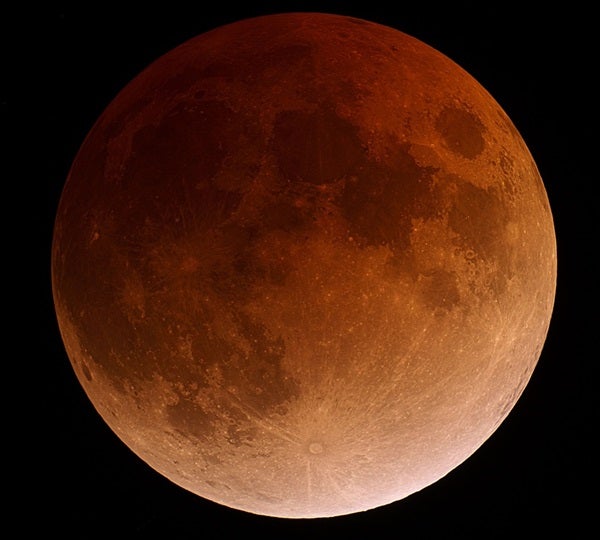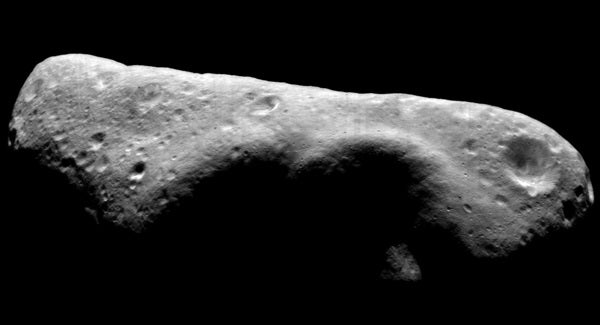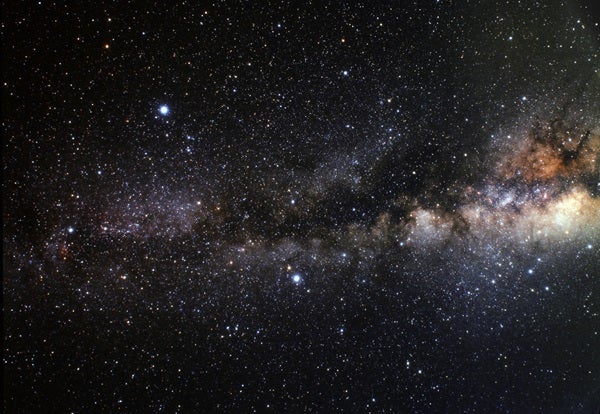Although Comet 46P/Wirtanen appeared brightest in mid-December, it currently glows at 6th magnitude and shows up nicely through binoculars or a telescope. This periodic visitor lies among the background stars of western Ursa Major, a region that remains visible all night but climbs highest around midnight local time. This evening, you can find Wirtanen just over 1° southeast of 3rd-magnitude Omicron () Ursae Majoris, the star that marks the nose of the Great Bear.
The dwarf planet Pluto is in conjunction with the Sun at 7 a.m. EST. The distant world then lies on the far side of the Sun from our perspective and can’t be seen.
Saturday, January 12
The waxing crescent Moon points the way to ruddy Mars this evening. The two lie about halfway to the zenith in the southwestern sky after darkness falls — with Mars about 5° to the Moon’s upper right — and remain a dynamic duo until they set around 11 p.m. local time. Mars remains a fixture in the evening sky all week. The ruddy world shines at magnitude 0.6 against the much dimmer background stars of Pisces the Fish. A telescope reveals a disk that spans 7″ and might show a few subtle surface features during moments of good seeing.
Sunday, January 13
You can find the First Quarter Moon high in the south as darkness falls tonight, then watch as it sinks toward the western horizon throughout the evening hours. Although our satellite doesn’t officially reach First Quarter phase until 1:46 a.m. EST tomorrow morning, you’ll be hard-pressed to see it as less than half-lit this evening. The Moon lies along the border between Pisces and Cetus.
Monday, January 14
One of the sky’s most familiar constellations rules January’s sky from dusk until near dawn. Orion the Hunter appears conspicuous in the southeast after darkness falls and climbs highest in the south around 10 p.m. local time. It then stands about halfway to the zenith from mid-northern latitudes. The night sky’s brightest star, Sirius, trails about an hour behind Orion.
Near-Earth asteroid 433 Eros makes its closest approach to Earth since 2012 today, when it comes within 19.4 million miles (31.2 million kilometers) of our planet. It glows at 9th magnitude all week and will be bright enough to see through small telescopes. The asteroid resides about 10° southwest of brilliant Capella this evening, a region that lies high in the east after darkness falls. Be sure to catch Eros sometime this month — it won’t be as close or as bright again until 2056.
Wednesday, January 16
Venus appears brilliant in the southeast before dawn. It reached greatest western elongation in early January and continues to dominate the predawn sky. The inner world shines at magnitude –4.5, more than 10 times brighter than the second-brightest planet, Jupiter. Venus rises 3.5 hours before the Sun and stands nearly 20° high when morning twilight begins. The planet lies among the background stars of western Ophiuchus, having crossed into the Serpent-bearer from Scorpius earlier this week. If you point a telescope at Venus, you’ll see a disk that spans 22″ and appears slightly more than half-lit.
Thursday, January 17
The variable star Algol in Perseus reaches minimum brightness at 6:59 p.m. EST, when it shines at magnitude 3.4. If you start viewing as soon as darkness falls, you can watch it more than triple in brightness (to magnitude 2.1) over the course of about five hours. This eclipsing binary star runs through a cycle from minimum to maximum and back every 2.87 days. Algol appears nearly overhead after sunset and sinks low in the northwest well after midnight.
Despite its name, the Summer Triangle emains on view in January’s early evening sky. The asterism’s brightest star, Vega, appears near the top of the image, while Deneb lies at lower left and Altair at lower right. In this scene, the triangle and the Milky Way stand above Yosemite Valley. Nevada Falls appears at the lower right of the picture with Vernal Falls below it.
For those who recently caught the observing bug, the so-called Summer Triangle must seem like a huge misnomer. That’s because this asterism remains on view after darkness falls in January. Look for Vega, the fifth-brightest star in the sky and the brightest triangle member, low in the northwest. Deneb lies above Vega and about one-third of the way to the zenith. Deneb marks the top of another asterism, the Northern Cross, which stands nearly straight up from the horizon on January evenings. Altair, the third triangle member, scrapes the western horizon and sets around 6:30 p.m. local time.
Saturday, January 19
Jupiter continues to grow more prominent in the southeastern sky before dawn. The giant planet rises three hours before our star and climbs 15° high in the southeast 45 minutes before sunup. Although Jupiter gleams at magnitude –1.8, it pales in comparison to Venus, which stands just above it. Four degrees separate these solar system luminaries this morning. They will continue to draw closer until they meet in a spectacular conjunction on the 22nd. A telescope reveals Jupiter’s 33″-diameter disk and at least two conspicuous cloud belts.
Sunday, January 20
Anyone with clear skies across the Americas can witness this week’s biggest event: a total eclipse of the Moon. The Full Moon, which arrives officially at 12:16 a.m. EST tomorrow morning (9:16 p.m. PST this evening), then lies deep in Earth’s shadow. The eclipse’s partial phases start at 10:34 p.m. EST. The shadow appears dusky gray at first, but as more of the Moon sinks into the shadow, it should take on a distinctly orange color. The color comes from sunlight refracted and scattered through Earth’s atmosphere, and appears most prominent during totality, which lasts from 11:41 p.m. to 12: 43 a.m.












